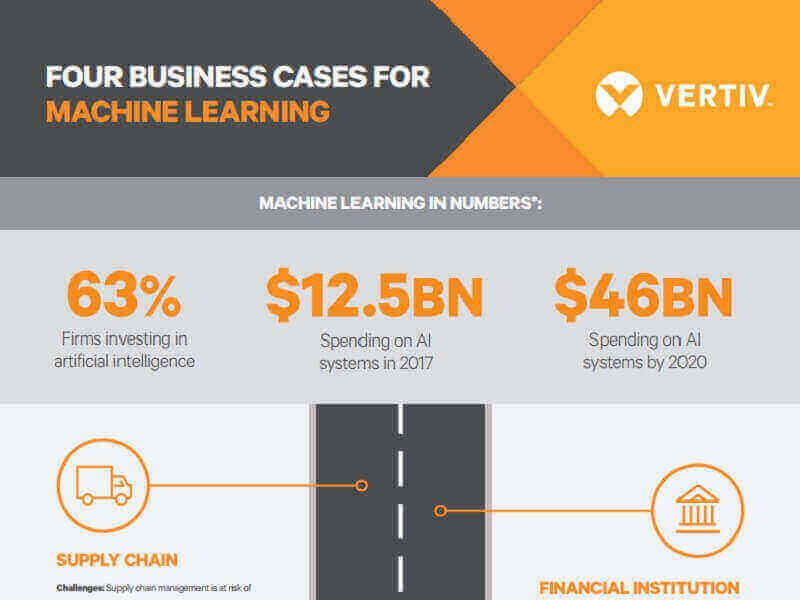Picture a dockyard, shipping containers swinging overhead. Imagine the chaos if one of those cranes failed, bringing many tonnes of cargo onto the people and containers below.
Now fast forward to a future defined by machine learning (ML) intelligence. A control box and automated alert system notifies engineers that the crane has an issue. On inspection, nothing is obvious... but the system has identified over time that the winch can develop a fault if the wind is above a certain speed, for a certain number of hours. The crane has ‘learnt’ its own weaknesses.
This sort of vision tells us that ML offers humanity the chance to get rid of our most dangerous and mundane activities. Repetitive tasks can be completed and improved upon, while complex environments can be understood and managed. ML will enable machines and software robots to take in information and adapt processes according to it, far quicker than we can introduce such advancements into their code.
Learning about machine learning
Looking at it simply, ML is the means by which machines use data to ‘learn’. Or as Gartner puts it, to operate guided and unguided, based on lessons provided by new information. The ‘decision’ to advance a particular action is determined by feedback loops which validate or invalidate that action. This is an important development in how machines will work for us. So much so that in PWC’s 2017 Global Digital IQ Survey, over half (54%) of surveyed organisations are already making substantial investments in artificial intelligence - of which ML is a key discipline. The number jumps to almost two thirds (63%) in a three year timeframe. That’s a lot of investment in our new robotic family. In fact, the value of this evolving sector is enormous. Spending on AI and cognitive systems is set to hit $12.5bn this year (2017) according to IDC.
But what exactly are these companies investing in? We’ve identified four areas in which ML is really going to change our world:
1. Machines that remove the gamble
Perhaps the most worthy of the ML use cases we explore here is the reduction of risk. In more industrial contexts, such as sites with heavy machinery or dangerous operating environments, ML is likely to reduce catastrophic incidents caused by equipment failure. It is also set to enable far greater reliability in facilities such as hospitals, where failures in operational systems or power could have dire consequences, thanks to a more adaptable and intelligent approach to automation.
This evolution will also improve the critical IT infrastructure that supports business operations, application performance and availability. Take a financial services organisation, where business leadership expects zero downtime and ultra-low latency for their trades. The prospect of a power loss is the stuff of nightmares for the CIO. ML has the potential to redefine the critical systems upon which such organisations rely. For example, the UPS of the future will preemptively alert engineering teams, and may be able to self-diagnose and resolve issues. With the right systems in place, the losses created by outages could be eliminated.
2. Machines that keep us secure
The security landscape is unforgiving. As defensive technology advances, so do the hackers who attack it. From the prevalence of endpoint devices such as smartphones and tablets, with their own unique vulnerabilities, through to the cloud revolution and the changes in security protocols, there’s a lot for security professionals to battle against. ML may help provide some of the answers. Gartner has identified that threat detection and security management products are likely to see a significant spike in their inclusion of ML capabilities. The mitigation of cyber security risk will demand greater analytics and real time responsiveness - to understand unusual traffic patterns or data flowing out of the network - which is going to require a speed of action simply not possible for humans or current technology. Whilst humans remain in the driving seat of cyber security today, it’s likely that we will soon see robots taking the lead. What hackers can do with that same technology is, of course, another matter...
3. Machines minding their own businesses
Many businesses will live or die by their ability to control costs and properly manage their supply chain. However, for a significant number of organisations, this relies on a combination of human insight and the automation of fast but unintelligent machines. Supply chains and logistics can become riddled with inefficiencies due to human error, the complexity of data and the challenge of ‘not knowing what you don’t know’. ML offers an opportunity to remove the weak links in the chain, and to vastly increase the scope and speed of the calculations involved in this process - particularly when it comes to identifying trends that might not otherwise have been discovered.
As the deployment of internet of things (IoT) technologies continues apace, the number of data sources available will increase vastly. In the future, navigational capabilities in vehicles will be enhanced, warehouses automated and ‘intelligent’ logistical planning made almost seamless. In time we may see robots procure goods on behalf of one business, receiving them from another that uses a fully automated, ML-based supply chain. Far from a commoditised space, supply chain logistics could become a focus of tech entrepreneurs and developer superstars in the future.
4. Machines as storytellers
While today we’re battling with the data needed to make informed commercial decisions, ML will revolutionise the way that organisations understand their customers. But it’s not just in terms of data analysis that ML will shake things up. Indeed, roles traditionally associated with intelligent and creative humans might soon be taken by our robotic friends. Wired magazine reports that robots could soon be sports reporters in the UK - a concept that may bring howls of despair from fans across the nation. The idea of machines that can tell us stories, while at the same time crunching inordinate volumes of data, opens up a plethora of new opportunities. So the future may be one in which it will be easier to create accurate and impactful marketing campaigns - but (for now at least) we still need that human readership to consume the products!
Learning to change
Even at this embryonic point, it’s clear why ML is usually met with a mixture of fascination and fear. Both sentiments may be justified. However, for all the doubts that may remain about the replacement of human skill sets with automation, it’s likely that ML will profoundly change many businesses. This will emerge through experiments into ‘soft skill’ areas such as marketing, as well as in fundamentally redefining how physics and engineering-led environments can be managed.
ML will impose pressures on IT teams to deliver an optimised infrastructure, but it will also help them complete their roles. It will allow a more predictive approach to IT management and offer adaptive ways of running power and cooling systems. For teams facing a skills shortage, ML-based automation will remove some of the headcount challenge. Like or loathe these concepts, IT professionals need to embrace them, because they are going to be at the ‘bleeding edge’ of this evolution.





